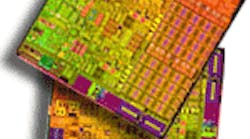Core i3 delivers a two-chip graphics display solution
Intel's Core i3 delivers more performance than Atom
Intel’s Core brand stratification is designed to simplify choices—at least when it comes to consumer-oriented applications. The entry-level Core i3, mid-range Core i5, and high-end Core i7 will be found in a range of devices from digital signage to high-end gaming PCs.
The challenge lies in figuring out which chips to utilize for a particular application because they span a range of environments. For example, mobile versions will be found in laptops. Add Atom to the bottom of the mix—as well as users who confuse netbooks, laptops, and the forthcoming smartbooks—and it’s easy to see that designers don’t have an easy job.
The Core i3 is likely to interest developers looking to build low-power devices for digital signage, embedded gaming, medical devices, and industrial automation and control. The latest 32-nm process technology is used in Intel’s dual-core 3.06-GHz Core i3-540 processor, which features Intel Hyper-Threading Technology providing four logical cores.
The chip is designed to mate with the Intel Q57 Express chipset or the Intel 3450 chipset to deliver a small-footprint, two-chip graphics display solution (see the figure). As with the latest Core i5 and i7 processors, the Core i3 is based on the Nehalem architecture with integrated memory controllers on the processor chip (see “The Right Combination Delivers The Best Desktop Performance”).
The Core i3 provides Intel virtualization support (VT-x) but not the TurboBoost feature found in the Core i5 and i7 processors. But it does include the latest set of idle states, enhanced Speedstep technology, and execute disable code protection. Because of its target application set, the Core i3 does not support Virtualization for Directed I/O (VT-d). VT-d is normally used in server and cloud applications, not embedded applications.
The Intel 3450 links to the processor using the 10-Gbit/s Direct Media Interface. It has eight PCI Express (PCIe) root ports with hot-plug support configurable in x1, x2, and x4 ports. There is also a PCI and LPC interface. The integrated AHCI controller handles up to six SATA II ports with RAID support for RAID 0, 1, 5, and 10. SATA support can be disabled.
The integrated Gigabit Ethernet controller supports jumbo frames. Two EHCI USB 2.0 host controllers can handle up to 14 external ports. Built-in HD audio support is implemented as a PCIe endpoint. It provides microphone array support as well as multichannel, 32-bit sample depth, 192-kHz sample rate output.
The chip incorporates a pair of cascade 8237 DMA controllers. It also supports SMBus, a pair of high-speed SPI ports, and a CMOS battery backed-up clock. Its impressive display support can handle a single analog display with a 350-MHz RAMDAC or up to three HDMI/DVI digital ports with resolutions up to 2560 by 1600 pixels. It has a 73-W thermal design power (TDP) as well.
The Core i3-540 costs $133. Its LGA2256 form factor allows it to fit in a range of motherboards.

